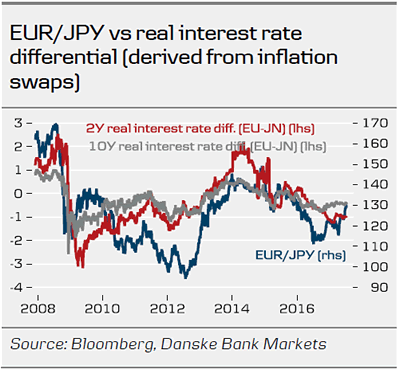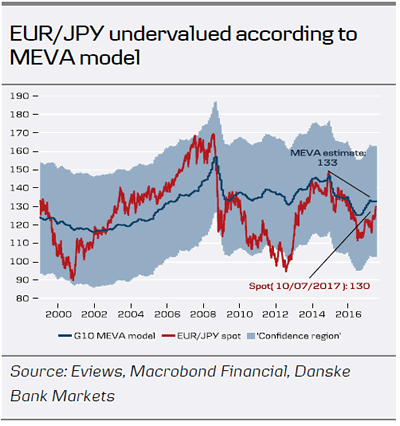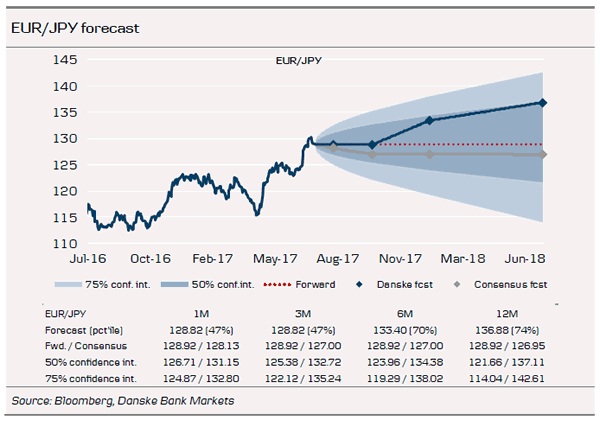We expect the Bank of Japan (BoJ) to maintain its ‘QQE with yield curve control’ policy unchanged at its monetary policy meeting ending on 20 July. It is widely expected that the BoJ will keep its monetary policy unchanged, especially after it earlier this month demonstrated its strong commitment to yield curve control by announcing an unlimited fixed-rate purchase of 10Y JGBs. The announcement should not have any significant impact on price actions.
Economy improving…
Since the previous BoJ meeting, data have been a little mixed. Exports, which have been the primary driver of economic growth in Japan for the past couple of years, showed weakening signs in Q2 following a few impressive quarters. However, Japanese exporters enjoyed a tailwind from the weak JPY in Q2 and in the recent Tankan business survey large enterprises were increasingly upbeat on exports, although expectations on domestic sales are actually the key driver in the better survey. Domestic demand has shown signs of improvement recently, with both retail sales and consumer confidence looking fairly good. The BoJ’s latest outlook report from late April showed expected 1.6% growth in real GDP for the fiscal year 2017, which would mean a further increase in the already-positive output gap. We could see a slight upward revision of this forecast on Thursday.
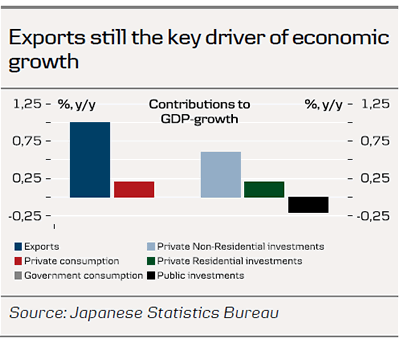
…but inflation outlook remains low
While the real economy is improving, consumer price inflation (CPI) has remained very low and we expect the BoJ to cut the outlook for CPI excluding fresh food (the measure BoJ targets) for the fiscal year 2017 from the current 1.4%. Inflation has increased in 2017 but it still stood at only 0.4 % y/y in May and wage inflation remains very low. Almost three decades of very low inflation mean companies are reluctant to raise prices and are trying to cut back on services and streamline their operations instead. The Tokyo inflation index, which follows the overall index closely, was completely flat year-on-year in June and, even though the labour market is still running hotter with the jobs to applicants ratio setting a new record each month, it looks as though it could still be a while before inflation begins to take off and the BoJ needs the global economic recovery to stay on track for this to happen.
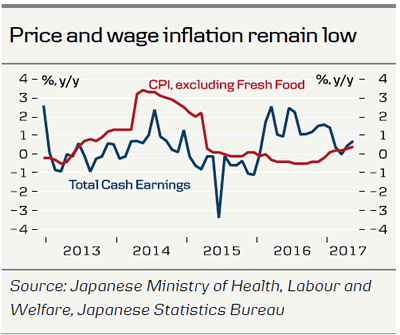
Rising political uncertainty the main risk to BoJ’s policy
The BoJ has explicitly promised to continue easing until inflation expectations are above the 2% target on a sustainable basis. In our main scenario, we expect the BoJ to keep its policy unchanged throughout our 12M forecast horizon, assuming that BoJ governor Haruhiko Kuroda is reappointed when his current term as governor ends in April 2018.
The main risk to the BoJ’s currently extremely accommodative policy stance is Prime Minister Shinzō Abe’s plummeting approval rating. Recently, it has tumbled to around 35% in the wake of a series of scandals involving Prime Minister Abe and his close political allies and accusations that he used his influence to secure the approval of a new department at a university run by a close friend.

While a possible change in the political leadership is not likely to affect monetary policy in the short term, a further increase in political uncertainty could potentially lead to a repricing of the BoJ further out on the curve, if markets start to speculate that Abenomics is coming to an end. The next important election is not until the general Lower House election in December 2018 and Abe thus still has time to regain voters’ trust. According to some media, Abe is planning to reshuffle his Cabinet at the beginning of August. However, this theme could potentially develop over the autumn and represents a downside risk to EUR/JPY and USD/JPY, if further scandals emerge or October’s by-election in the Shikoku area turns into defeat.
FX outlook: EUR/JPY and USD/JPY higher 6-12M
The JPY has weakened significantly over the past month, as the BoJ (in contrast to the ECB, BoC and Bank of England, which all recently changed their communication in a more hawkish direction) remains on easing bias and recently demonstrated its commitment to its yield curve control.
According to the latest IMM data, non-commercial JPY positioning is now back in stretched short territory, suggesting that the JPY sell-off is likely to lose momentum in the short term. However, we expect the JPY to continue to underperform vis-à-vis the USD and EUR in a scenario with rising global yields and, given the relatively soft pricing of the Fed, both in terms of rate hikes and balance sheet reduction, we expect relative monetary policy to support USD/JPY in coming months, targeting the cross at 114 in 1-3M. See FX Forecast Update: A ‘Sintra accord’? Maybe, but it has yet to be signed by the Scandies (14 July).
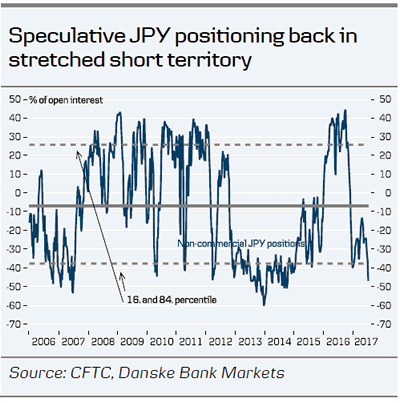
In respect of EUR/JPY, we expect the cross to trade in the range of 127-131 in the coming months, targeting 128.8 in 1-3M. We expect the ECB to deliver only a minor hawkish twist at its July meeting, which, if anything, could add to the upside risks for EUR/JPY. See ECB Preview: Another minor hawkish twist (14 July). Longer term, we expect EUR/JPY to continue higher driven by real interest rates and portfolio outflows out of Japan, as we expect the ECB to move towards monetary policy ‘normalisation’ before the BoJ. We target EUR/JPY at 133.4 in 6M and 136.88 in 12M.
According to Danske Bank’s MEVA model, EUR/JPY still trades below the model’s fair value of 133. Hence, from a fundamental point of view, the case for further EUR/JPY gains remains intact for now. See FX Strategy: Danske G10 MEVA – EUR/USD gravitational pull kicks in (10 July) for details.
